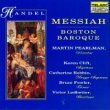CHORUS
Glory to God in the highest, and peace on earth, goodwill towards men.
This chorus is a wonderful example of Handel’s genius at communicating through music and shows the degree to which his long experience of composing operas informs this oratorio. There are three dimensions to the picture. First is the depiction of the angels’ location, changing from hovering very high above the shepherds’ head to standing right on the ground in front of them. Second is the way the message is transmitted. Third is the ambient activity in the course of the angels’ delivery of the message.
The first statement "glory to God" has the regal dotted rhythm in it, and two trumpets–symbols of royalty–join in “from afar and a little softly.” Violin activity suggests a great swarming of the heavenly host. The chorus begins from the angels’ position high above the shepherds. The vocal and instrumental parts sit up in the high range. The choral basses are not singing, and the tenors’ part lies from A below middle C to the A an octave above! The continuo bass doubles the tenors, using only the cello (omitting the violone and bassoon, which will be brought in later). A flurry of angel wings descends in the violins following the first declamation.
"Peace on earth" is on one pitch (and its octave) in longer notes, an extremely placid melodic profile. Its first occurrence is presented in the tenor and basses, doubled by all the instruments. The bass part leaps down an octave, suggesting peace bestowed from heaven above to humanity below. In every statement of this text phrase, the octave descent is present.
Following this proclamation, the angels remain hovering for a moment, then repeat “Glory to God in the highest.” As they do, there is again much fluttering in the violins. The basses are still absent, but the tenors have begun to visit a few of the lower notes more frequently, and the sopranos and altos have exchanged pitches of the opening chords, so they now sit in a more moderate range. The multitude is gradually coming closer to ground level.
A second statement of “peace on earth” has both tenor and bass falling the octave. Again, the angels “hover” for a moment.
Handel introduces "goodwill toward men" in a kind of short fugetto, suggesting that the distribution of good will is always in some way imitative. During the beginning of this section the strings and oboes double the voices, but at the cadence the 16th-note flurry begins again and continues through the third and final statement "Glory to God", until “peace on earth” is again proclaimed. This third “Glory to God” brings the angels virtually on the same plane with the shepherds. The choral basses are now providing chordal roots and the other voices are in a normal position. The orchestra employs not only trumpets and oboes, but also lower strings and bassoon. [Excerpt 30] After a final “peace on earth”, “goodwill” is revisited, again beginning imitatively; then Handel has the sopranos offer and the lower three voices respond. Finally all the world is in accord in promoting goodwill together.
Lest the angels be abandoned on earth, Handel creates a wonderful coda in which the solo strings and continuo bass gradually rise upward and become increasingly invisible. A final light trill in the violins is the last flutter we perceive of the wings. [Excerpt 31]
PAGE 1 2 3 4 5 6 7 8 9 10 11 12 13
|

